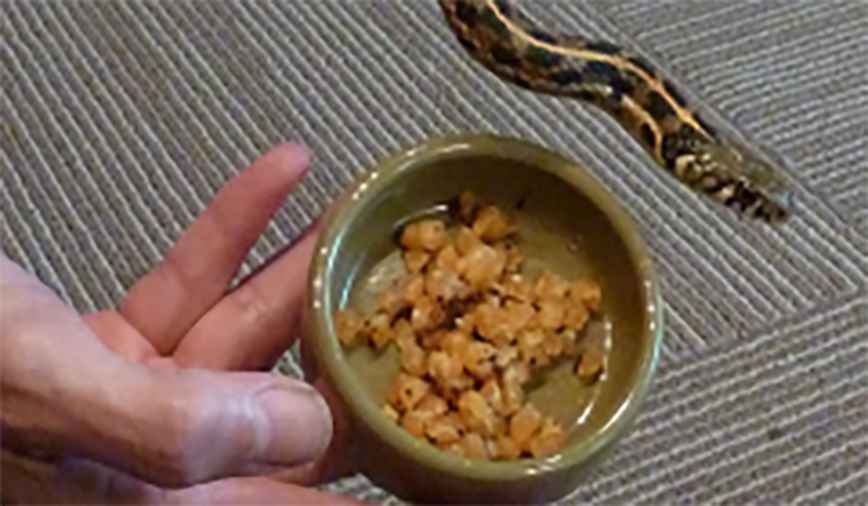Did anyone else catch this Washington Post headline a few weeks back?
“Lady snake gives birth after being alone for eight years, doesn’t need men”
Other news media jumped on the story too, crafting equally tantalizing titles. From the web site livescience.com: No Boys Allowed: Snake Mom Has ‘Virgin Birth’. And from Discover magazine: Water Snake in Missouri Gives ‘Virgin Birth,’ Again
The long and short of it all was that a female yellow-bellied water snake, housed alone at the Cape Girardeau Conservation Nature Center, produced young two years in a row. While no offspring from this year’s event survived, two snakes from last year’s litter are still alive and kicking. Er, squiggling.
Although some reptiles are able to produce young several years after a single mating, staff at the Missouri Department of Conservation say the process was not possible in this particular case; instead, the offspring came about via parthenogenesis—that is, eggs that develop without fertilization.
MDOC herpetologist Jeff Briggler in a press release said that parthenogenesis seems to occur in both captive and wild situations and it doesn’t seem to impact the health of the female snake. He added that as more genetic work is conducted, it may turn out that parthenogenesis is more widespread than scientists have thought in the past.
At this point you may be wondering, while this news is mildly interesting, what in the world does it have to do with current happenings in the TriCities?
Believe it or not, there is a link. A link with a keyword: Jelly beans.
The snake in Cape Girardeau, in addition to actual baby snakes, also produced a number of round, soft, egg-like structures—freshly laid membranes. (Water snakes and garter snakes are two species often thought of as giving birth to live young, as opposed to laying eggs. Actually though, the young do develop inside eggs, but rather than depositing the eggs somewhere, the female incubates them inside her body until the young are ready to emerge.)
These round, soft egg-like structures are referred to by snake fanciers as jelly beans.
If you’ve ever been to Hickory Knolls, and seen the large number of snakes we have on display, you might now be able to guess where this story is heading.
Several weeks ago here at Hickory Knolls, as staff were performing some routine maintenance on our live garter snake display, I heard a loud pronouncement from the Exhibit Room: “Gertrude laid eggs!”
As someone who’s had more than a casual interest in snakes, especially garter snakes, for over 40 years, I at first thought this discovery had to be a mistake. “Garters don’t lay eggs,” I said, mainly to myself, as I scurried over to the scene.
But, sure enough, there in Gertrude’s enclosure, were a couple dozen golden globs, each about the size of a Jelly Belly jelly bean. We quickly ruled out other possibilities like uneaten food, or fungus growing on the substrate. Which then caused a shift in staff efforts, from cleaning and tidying to reading and Googling.
What we learned is that the yellow material consisted of unfertilized eggs, and that they can be called “slugs” in addition to “jelly beans.” Their production seems to be a normal part of life for a mature female garter, although they are not usually produced in the quantity we observed.
We also came across a list of snakes species known have reproduced parthenogenetically. There on the page, one name jumped out at us: Thamnophis marcianus, the checkered garter. The exact species Gertrude happens to be.
Now I’m not claiming that she will one day be making headlines. But if she does, I can guarantee you will read about it here first. For the time being though, we will continue to watch and care for our girl, who clearly is quite fertile. To the extent, in fact, that we’re considering changing her name to Myrtle.
Pam Otto is the manager of nature programs and interpretive services at the Hickory Knolls Discovery Center, a facility of the St. Charles Park District. She can be reached at 630-513-4346 or potto@stcparks.org.
October 9, 2015
Gertrude the Garter Snake
Here Gertrude the Garter Snake is shown alongside her clutch of ‘jelly beans,’ or unfertilized eggs. Garter snakes are one of several types of snakes known to be able to reproduce without the presence of a male, a process known as parthenogenesis.

